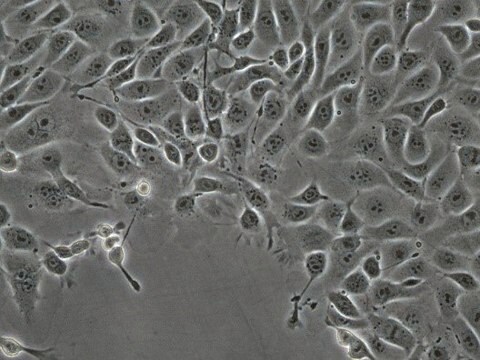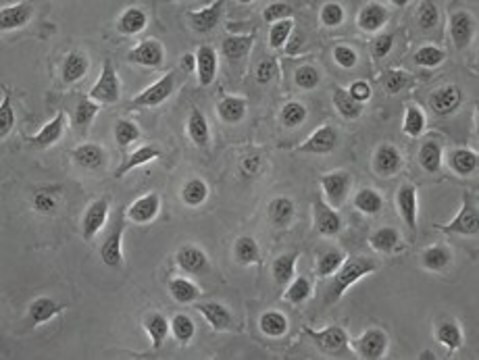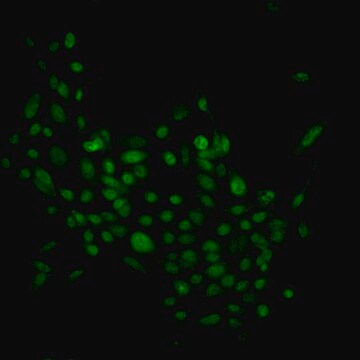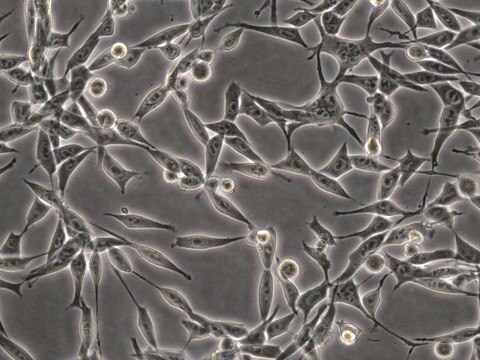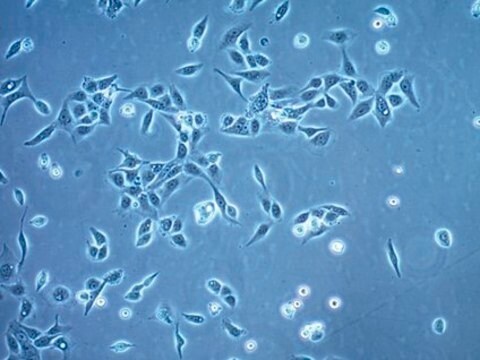推荐产品
产品名称
MOC22 Mouse Oral Squamous Cell Carcinoma (OSCC) Cell Line,
生物源
mouse
品質等級
包裝
vial of ≥1X10⁶ cells/vial vials
製造商/商標名
Millipore
技術
cell culture | mammalian: suitable
運輸包裝
liquid nitrogen
儲存溫度
−196°C
應用
- Each vial contains >1X106 viable cells.
- MOC22 cells are verified to be of mouse origin and negative for human, rat, Chinese hamster, Golden Syrian hamster, and non-human primate interspecies contamination, as assessed by a Contamination Clear panel by Charles River Animal Diagnostic Services
- Cells tested negative for infectious diseases against a Mouse Essential CLEAR panel by Charles River Animal Diagnostic Services.
- Cells tested negative for mycoplasma.
特點和優勢
The MOC (Mouse Oral Cancer) cell lines provide a syngeneic HNSCC cancer model that can be transplanted into C57BL/6 mice. These lines are important models for immune cell infiltration studies. The MOC lines have been utilized to compare and identify potential clinical scenarios that are applicable to human Oral Squamous Cell Carcinoma. The MOC22 cell line was derived from primary tumors in a C57BL/6 WT mouse and shows indolent growth compared with the aggressive, metastatic MOC2 line.
標靶描述
Despite ongoing efforts to understand growth and signaling pathways in head and neck squamous cell carcinoma (HNSCC), patient outcomes have remained largely unchanged in recent decades. A significant barrier to understanding and studying immune responses in the context of cancer in recent years has been the lack of available syngeneic mouse models. Xenograft approaches have historically been popular models, but they unfortunately do not model important adapative immunity responses.The MOC cell lines have expanded our understanding of CXCL14 downregulation in metastatic lymph nodes. Previously, CXCL14 expression had been associated with T-cell associated mechanisms for tumor suppression. Tumor Infiltrating Lymphocyte (TIL) studies using MOC1 and MOC2 have found a cell-specific association in Oral Squamous Cell Carcinomas (OSCCs) involving CXCL14 downregulation resulting in TIL increase which leads to tumor suppression.The MOC group of cell lines contained common HNSCC mutations in addition to human-related OSCC driver pathways. All MOC lines share RAS pathway mutations and MOC22 was found to have HRAS mutations which is relevant in relation to human HRAS-mutant OSCC groups. Source: The MOC22 cell line was derived from carcinogen-induced oral tumors in immunocompetent C57BL/6 mice.References: 1. Judd, N. P., Allen, C. T., Winkler, A. E., & Uppaluri, R. (2012). Comparative analysis of tumor-infiltrating lymphocytes in a syngeneic mouse model of oral cancer. Otolaryngology--Head and Neck Surgery, 147(3), 493-500.2. Parikh, A., Shin, J., Faquin, W., Lin, D. T., Tirosh, I., Sunwoo, J. B., & Puram, S. V. (2020). Malignant cell-specific CXCL14 promotes tumor lymphocyte infiltration in oral cavity squamous cell carcinoma. Journal for ImmunoTherapy of Cancer, 8(2).3. Onken, M. D., Winkler, A. E., Kanchi, K. L., Chalivendra, V., Law, J. H., Rickert, C. G., ... & Uppaluri, R. (2014). A surprising cross-species conservation in the genomic landscape of mouse and human oral cancer identifies a transcriptional signature predicting metastatic disease. Clinical Cancer Research, 20(11), 2873-2884.
儲存和穩定性
MOC22 cells should be stored in liquid nitrogen until use. The cells can be cultured for at least 10 passages after initial thawing without significantly affecting cell marker expression and functionality.
免責聲明
Unless otherwise stated in our catalog or other company documentation accompanying the product(s), our products are intended for research use only and are not to be used for any other purpose, which includes but is not limited to, unauthorized commercial uses, in vitro diagnostic uses, ex vivo or in vivo therapeutic uses or any type of consumption or application to humans or animals.
儲存類別代碼
10 - Combustible liquids
水污染物質分類(WGK)
WGK 3
閃點(°F)
Not applicable
閃點(°C)
Not applicable
我们的科学家团队拥有各种研究领域经验,包括生命科学、材料科学、化学合成、色谱、分析及许多其他领域.
联系技术服务部门